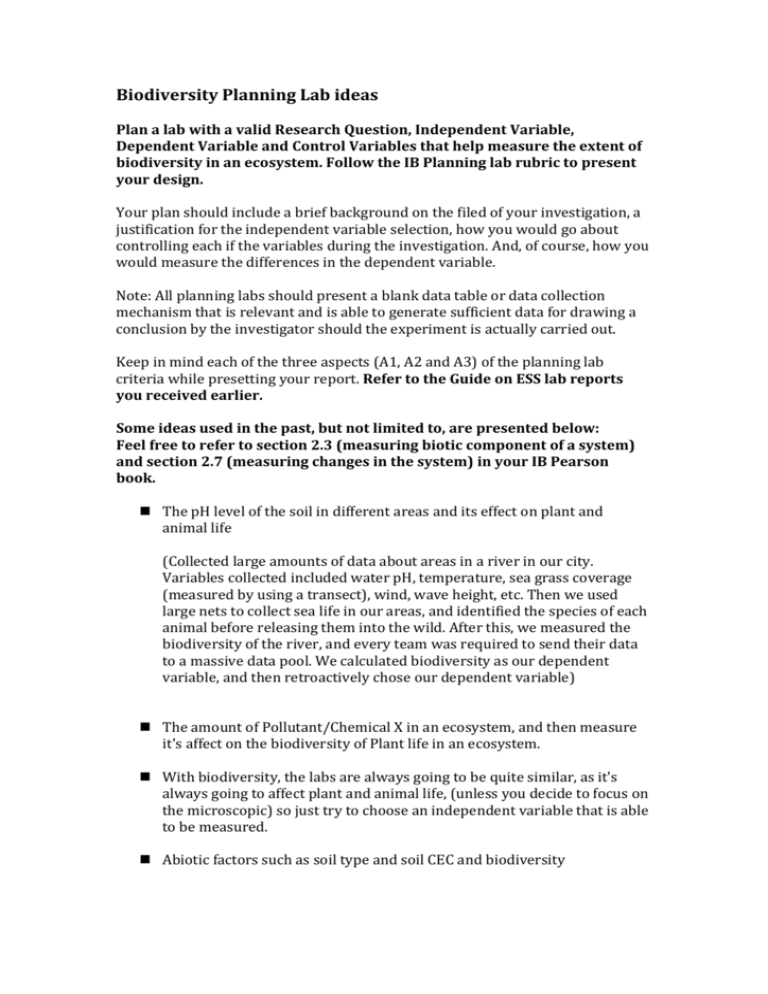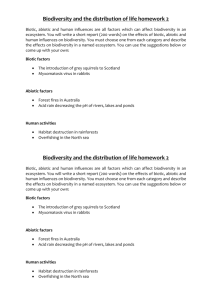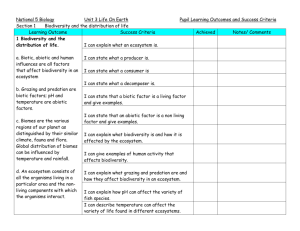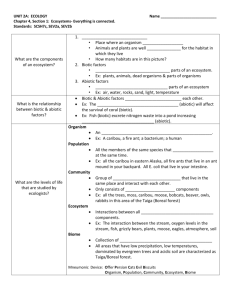Biodiversity Planning Lab ideas
advertisement

Biodiversity Planning Lab ideas Plan a lab with a valid Research Question, Independent Variable, Dependent Variable and Control Variables that help measure the extent of biodiversity in an ecosystem. Follow the IB Planning lab rubric to present your design. Your plan should include a brief background on the filed of your investigation, a justification for the independent variable selection, how you would go about controlling each if the variables during the investigation. And, of course, how you would measure the differences in the dependent variable. Note: All planning labs should present a blank data table or data collection mechanism that is relevant and is able to generate sufficient data for drawing a conclusion by the investigator should the experiment is actually carried out. Keep in mind each of the three aspects (A1, A2 and A3) of the planning lab criteria while presetting your report. Refer to the Guide on ESS lab reports you received earlier. Some ideas used in the past, but not limited to, are presented below: Feel free to refer to section 2.3 (measuring biotic component of a system) and section 2.7 (measuring changes in the system) in your IB Pearson book. The pH level of the soil in different areas and its effect on plant and animal life (Collected large amounts of data about areas in a river in our city. Variables collected included water pH, temperature, sea grass coverage (measured by using a transect), wind, wave height, etc. Then we used large nets to collect sea life in our areas, and identified the species of each animal before releasing them into the wild. After this, we measured the biodiversity of the river, and every team was required to send their data to a massive data pool. We calculated biodiversity as our dependent variable, and then retroactively chose our dependent variable) The amount of Pollutant/Chemical X in an ecosystem, and then measure it's affect on the biodiversity of Plant life in an ecosystem. With biodiversity, the labs are always going to be quite similar, as it's always going to affect plant and animal life, (unless you decide to focus on the microscopic) so just try to choose an independent variable that is able to be measured. Abiotic factors such as soil type and soil CEC and biodiversity Some questions to think about….. Q. How does biological diversity relate to the characteristics of the abiotic factors of an ecosystem? The availability of abiotic factors like light, moisture, mineral salts, heat and carbon dioxide, more or less conditions the biodiversity of an ecosystem. Photosynthesis depends on water and light, and plants also need mineral salts, carbon dioxide and adequate temperature for their cells to work. In environments where these factors are not restrictive the synthesis of organic material (by photosynthesis) is at a maximum, plants and algae can reproduce easier, the population of these beings increase, potential ecological niches multiply and new species emerge. The large mass of producers makes viable the appearing of a diversity of consumers of several orders. In environments with restrictive abiotic factors, like deserts, the producers exist in small numbers and less diversity, a feature that thus extends to consumers and conditions fewer ecological niches to be explored. Q. How does the vegetal stratification of an ecosystem influence the biological diversity? The vegetal stratification of an ecosystem, like the strata of the Amazon Rainforest, creates vertical layers with peculiar abiotic and biotic factors, dividing the ecosystem into several different environments. Therefore in the superior layer near the crowns of big trees the exposition to light, rain and wind is greater but moisture is lower compared to the inferior layers. As one goes down the strata the penetration of light diminishes and moisture increases. Regarding the biotic factors, communities of each stratum present differ in composition and features, food habits, reproduction strategies, etc. Such variations in the abiotic and biotic factors make the selective pressure upon living beings to be also diversified, there are more ecological niches to be explored and more varied beings emerge during the evolutionary process.










